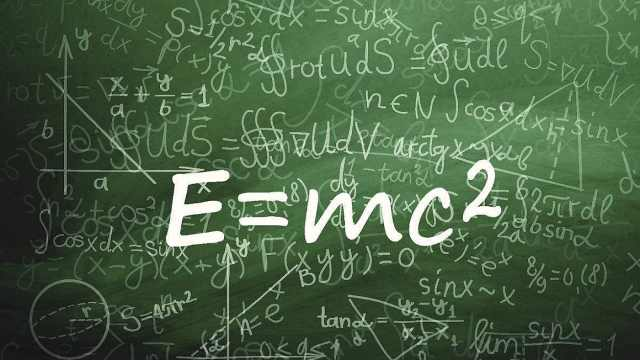
$$e=mc^2$$
Theorem
The energy imparted to a body to cause that body to move causes the body to increase in mass by a value 𝑀 as given by the equation:
$$
E = M c^2
$$
where 𝑐 is the speed of light.
Proof
From Einstein’s Law of Motion, we have:
$$
\mathbf F = \dfrac {m_0 \mathbf a} {\left({1 - \dfrac {v^2} {c^2}}\right)^{\tfrac 3 2}}
$$
where:
- 𝐅 is the force on the body
- 𝐚 is the acceleration induced on the body
- 𝑣 is the magnitude of the velocity of the body
- 𝑐 is the speed of light
- 𝑚0 is the rest mass of the body.
Without loss of generality, assume that the body is starting from rest at the origin of a cartesian coordinate plane.
Assume the force 𝐅 on the body is in the positive direction along the x-axis.
To simplify the work, we consider the acceleration as a scalar quantity and write it 𝑎.
Thus, from the Chain Rule:
$$
a = \dfrac{\mathrm d v}{\mathrm d t} = \dfrac{\mathrm d v}{\mathrm d x} \dfrac {\mathrm d x}{\mathrm d t} = v \dfrac {\mathrm d v} {\mathrm d x}
$$
Then from the definition of energy:
$$
\displaystyle E = \int_0^x F \mathrm d x
$$
which leads us to:
$$E = m_0 \int_0^x \frac a {\left({1 - v^2 / c^2}\right)^{\tfrac 3 2} } \ \mathrm d x $$
$$ = m_0 \int_0^v \frac v {\left({1 - v^2 / c^2}\right)^{\tfrac 3 2} } \ \mathrm d v $$
$$ = m_0 \left({- \frac {c^2} 2}\right) \int_0^v \left({1 - \frac {v^2} {c^2} }\right)^{-\tfrac 3 2} \left({- \frac {2 v \ \mathrm d v} {c^2} }\right) $$
$$ = \left[{m_0 c^2 \left({1 - \frac {v^2} {c^2} }\right)^{- \tfrac 1 2} }\right]_0^v $$
$$ = m_0 c^2 \left({\frac 1 {\sqrt {1 - \frac {v^2} {c^2} } } - 1}\right) $$
$$ = c^2 \left({\frac {m_0} {\sqrt {1 - \frac {v^2} {c^2} } } - m_0}\right) $$
$$ = c^2 \left({m - m_0}\right) $$
$$ = M c^2$$
Sources
- 1972: George F. Simmons: Differential Equations … (previous) … (next): Miscellaneous Problems for Chapter 2: Problem 32
- 1992: George F. Simmons: Calculus Gems … (previous) … (next): Chapter B.7: A Simple Approach to $E = M c^2$

